Exploring the Fujian Tulou Posted by sasha on Jan 16, 2015 in Culture
On our recent trip to Fujian province, we started off with a short beach vacation in Xiamen. While we had a good time exploring Gulangyu island and wandering through the night market, the main reason for coming to southeast China was to get out and see the famed tulou (土楼 – tǔ lóu) villages. These “earthen buildings” were constructed as communal dwellings by the Hakka and Minnan people between the 12th and 20th centuries. Most tulou are either circular or rectangular, feature tall, fortified mud walls, and are between 3-5 stories high. Following the concept of “open inside, closed outside,” these structures were built with defense in mind. When they were being built, armed bandits were a big concern in the region. As such, most tulou have only one entrance, no windows on the first floor, and small gun ports at the top.
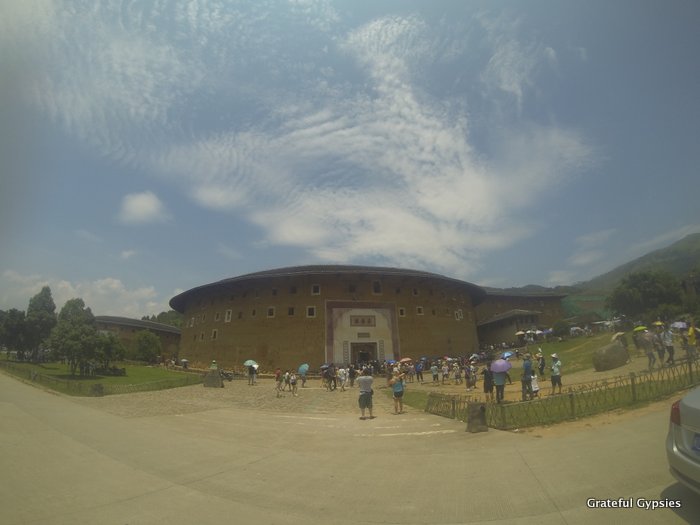
One of the many tulou structures in Fujian.
While the outside was meant to deter unwanted visitors, the inside of these fascinating buildings is meant to be an open communal living space. Once upon a time, entire clans would live inside just one tulou – up to 800 people of one big extended family living together. Traditionally, there is an ancestral shrine in the center of the complex. One or two floors make up the residential section, with the remaining floors used as storage, kitchens, and meeting rooms. Although there are purportedly thousands of tulou scattered across Fujian, 46 of the buildings were inscribed as a UNESCO World Heritage Site in 2008 as “exceptional examples of a building tradition and function exemplifying a particular type of communal living and defensive organization [in a] harmonious relationship with their environment.”
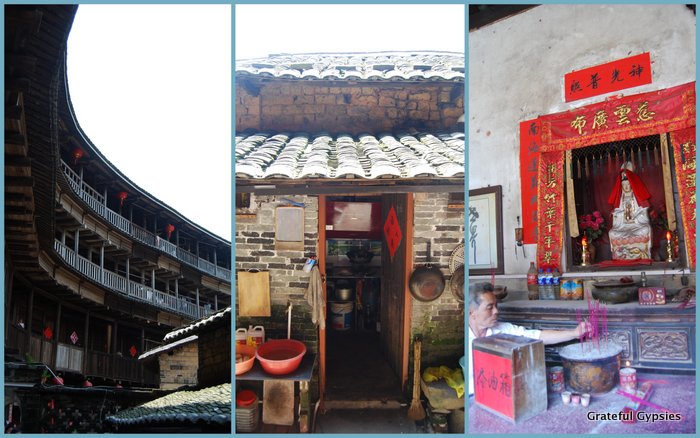
A glimpse into a tulou.
With young people leaving to find work in the big cities and plenty of elders opting to forego the traditional communal living in favor of modern luxuries such as indoor plumbing and cable TV, most of the tulou no longer have residents. Some, such as one we visited while cycling through a small village, are completely barren save for a disgruntled old dog and some old wall decorations. Others, such as the so called “king of tulou” Chengqilou (承啟樓), are still bustling with life. The only difference is that residents now make a living selling tea and cigarettes to tourists instead of farming. With busloads of people pulling up day after day, business is good.
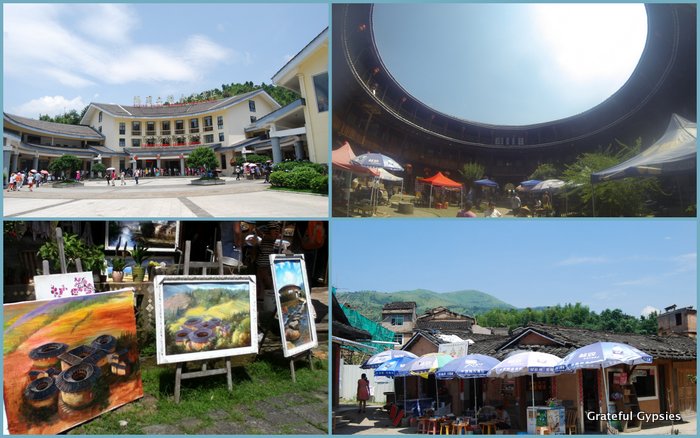
Some shots of the Gaobei cluster.
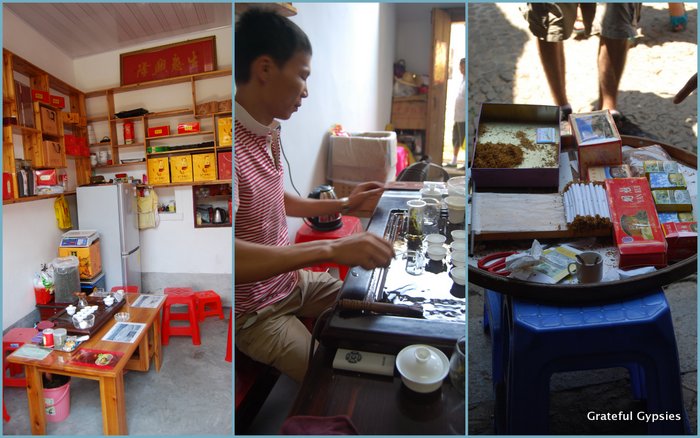
The new business of tulou dwellers.
After checking into our hostel and arranging transportation, we first visited the Gaobei (高北 – gāo běi) cluster, famous for the above-mentioned “king of tulou.” While it is quite an impressive structure, it was hard to enjoy walking elbow-to-elbow with massive groups of tourists. This cluster has been built up more so than others and heavily promoted for tourism, so it’s best to get this one out of the way first and then visit smaller, quieter places. Inside Chengqilou, visitors are not allowed to go upstairs. You can however pay 20 RMB to have a photo taken from up high for you.
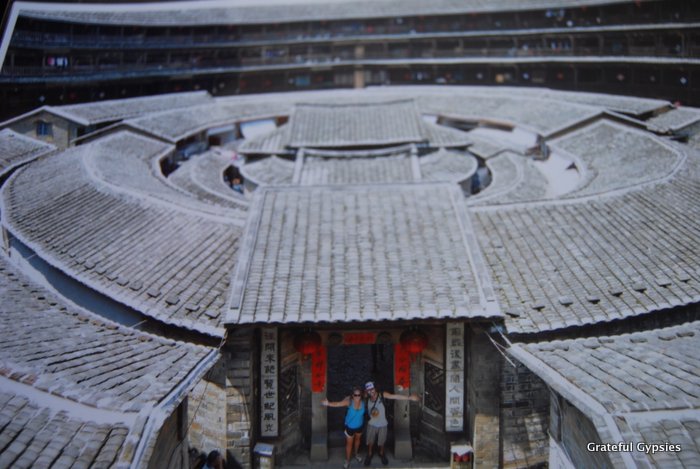
The “king of tulou” from above.
In a neighboring structure, we pushed through the maze of umbrellas and knick-knack stands to check out the interior. Next thing we knew, a local granny was motioning to take us to the top floor. Of course, she required a small tip for her services, but it was nice to finally see the hallways, rooms, and view from above.
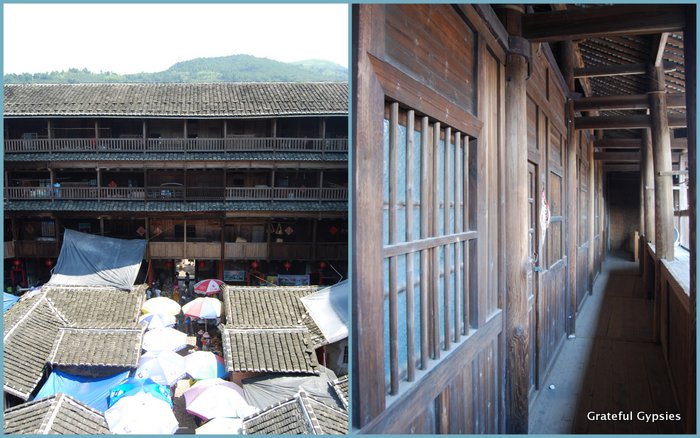
We paid a nice granny 10 RMB to get to the top floor.
That evening, we cycled through the village up the road from our hostel. A far contrast from the highly developed area we had visited that morning, the village was pure rural China – peaceful, quiet, and completely devoid of tourists. When we asked a local guy if we could go into the tulou to have a look, he replied – “Sure, go for it. No one lives there anymore! Everyone has moved into apartments.”

A small village with an empty tulou.
Another villager offered to take us on a short tour of the local temple. Wandering through a village and interacting with the locals was a nice change of pace from the mega-cities we had visited on our trip prior to our arrival at the tulou.
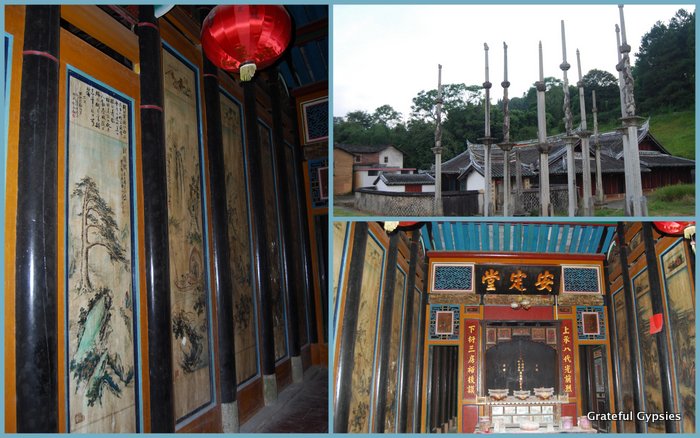
Inside the village temple.
For our second day, we headed out to the Chuxi (初溪 – chū xī) group with a driver. Before going in to check out any of the buildings, we climbed the short path up to the viewpoint. It was well worth the short walk, as this was easily the best view we got of the tulou from above.

The Chuxi group from above.
Although this section has been developed somewhat for tourism, it’s much less crowded than Gaobei. There are of course a few vendors here, but we found our visit to Chuxi much more enjoyable. There were hardly any other tourists there on our visit – we were even able to fit in a game of ping pong in the ancestral hall of one building.
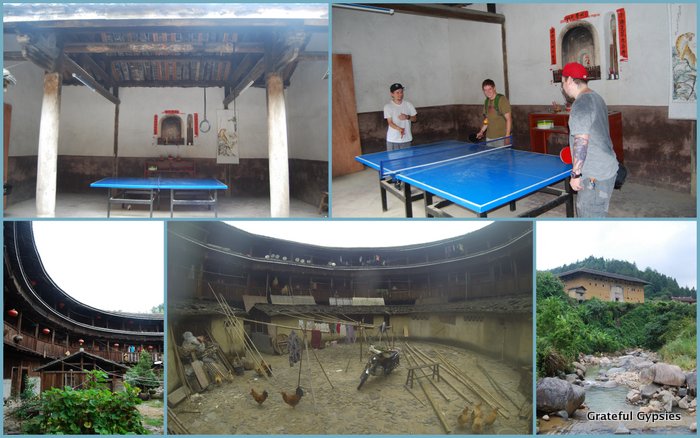
Chickens and ping pong at Chuxi.
The main structure here has been converted into a small museum, where you can learn more about the Hakka people and their culture. You can also learn about the tulou structures themselves – how and why they were built. We had fun goofing around with the replica weapons.
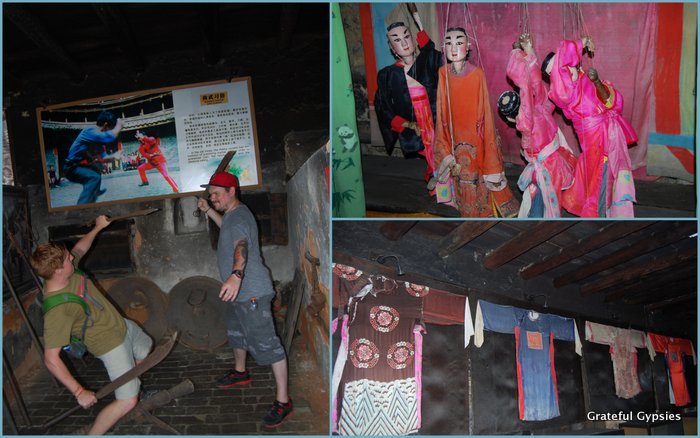
Having fun in the museum.
While perusing the artifacts was nice, the highlight was definitely taking in the views from the top floor. Free of umbrellas, souvenir shops, and pushy tourists, this was exactly what we had come all the way here to see.

Exploring the tulou of Chuxi.
Planning a trip out to see the tulou on your own can be a bit tricky, as they are spread out all over Fujian province. In the end, I was quite happy with the way we did it – staying in the area for two nights and visiting a few different clusters via bicycle and hired driver. This is highly recommended instead of just taking a day trip from Xiamen, since you’d spend most of the day on the bus and most likely only see one of the super touristy sections.

Build vocabulary, practice pronunciation, and more with Transparent Language Online. Available anytime, anywhere, on any device.
About the Author: sasha
Sasha is an English teacher, writer, photographer, and videographer from the great state of Michigan. Upon graduating from Michigan State University, he moved to China and spent 5+ years living, working, studying, and traveling there. He also studied Indonesian Language & Culture in Bali for a year. He and his wife run the travel blog Grateful Gypsies, and they're currently trying the digital nomad lifestyle across Latin America.




Comments:
Lilla:
Hi Sasha!
Great advice on the tulous! I’m hoping to go there next week; could you advise me as to which hostel you stayed in?
Thanks!
Lilla
sasha:
@Lilla Hey Lilla,
You’re going to love the tulou villages! We stayed at the Panda Hostel in the town of Yongding. You can cycle to one village that has a few run-down tulous, but you’ll need to get a driver for trips further afield. Panda is a nice guy and can easily arrange that for you. His place is on hostelworld.com (http://www.hostelworld.com/hosteldetails.php/Panda-Hostel/Yongding/85981?sc_sau=sfab&sc_pos=2). Enjoy your trip!
-Sasha